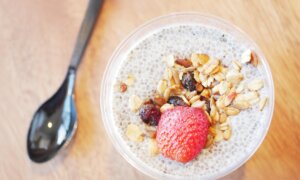“Migraines are a neurological disorder and are a result of neural inflammation,” Dr. Fred Cohen, assistant professor of medicine and neurology at the Icahn School of Medicine at Mount Sinai in New York City, told The Epoch Times.
What sets them off can vary—some people are triggered by external factors—and while there are some common patterns, each migraine is unique, he said.
He recalled one patient who kept a detailed headache log. Her migraines always seemed to strike in the morning. Curious, he asked about her breakfast. “Eggs,” she said. “Eggs?” he remembers thinking. “Are eggs a trigger?” He hadn’t encountered that before and hasn’t since—but for her, it was. “The range of triggers can be incredibly individual,” Cohen said.
Another potential trigger for some people is monosodium glutamate or MSG.
Concerns over the adverse health effects of MSG were first proposed in a controversial letter to the New England Journal of Medicine in 1968. Since then, with regard to migraines being triggered by MSG, the association has seen mixed findings in clinical trials. Nevertheless, specialists still recognize MSG may not be well-tolerated by everyone.
The Link Between MSG and Migraines
MSG, a common flavor enhancer found in foods such as soups, snacks, and takeout, has long been suspected as a migraine trigger for some people. At the heart of this connection is glutamate—an amino acid naturally produced in the body.
“Glutamate is essentially neuron fuel,” Cohen said.
The brain uses it heavily, and when consumed, it can activate many different neural pathways, he added.
Such activation matters for migraine sufferers because many types of glutamate receptors are found in the brainstem and spinal cord—key areas involved in migraine pain processing. Studies have shown that people with migraines tend to have higher levels of glutamate in their blood than people without migraines or those who experience other types of headaches. During a migraine episode, glutamate levels climb even higher.
MSG may trigger migraines by overstimulating glutamate-sensitive brain regions, making the nerves in the head more reactive to pain. Even among people who do not suffer from migraines, MSG has been linked to symptoms such as headaches, facial pressure, and nausea.
However, most people tolerate MSG without any issues.
“It really depends on the individual,” Wesley McWhorter, a registered dietitian nutritionist with a doctorate in public health, told The Epoch Times.
It’s important to look at MSG regarding someone’s overall diet and personal sensitivity.
Where MSG Hides
When most people think of MSG, they might picture takeout meals, bags of chips, or highly processed foods—and they’re right. MSG is widely used as a flavor enhancer in processed and restaurant foods, especially savory dishes. But more than an additive—MSG, or glutamate—also occurs naturally in many everyday foods.
This naturally occurring amino acid is found in foods such as tomatoes, Parmesan and cheddar cheese, anchovies, sardines, seaweed, and kelp, Cohen said.
“Everyone’s threshold is different. Some people may tolerate natural sources like cheese or tomatoes without issue, while processed foods containing higher concentrations could pose a greater risk,” he said.
Strategies to Reduce the Risks
While there are no specific foods that cancel out the effects of MSG, eating it as part of a balanced meal—especially with starchy foods such as rice or potatoes—may help reduce potential side effects.
“The negative effects of MSG appear to be attenuated when consumed with other foods,” Zubair Ahmed, a professor of neuroscience at the University of Birmingham, told The Epoch Times.
McWhorter also shared general strategies to help lower migraine risk:
- Stay hydrated: Dehydration is a well-known migraine trigger. Drinking enough fluids supports overall neurological stability.
- Don’t skip meals: Irregular eating can lead to blood sugar drops, heightening sensitivity to food additives and other triggers.
- Eat magnesium-rich foods: Leafy greens, nuts, seeds, and whole grains have been linked to lower migraine frequency in some people.
- Avoid stacking triggers: Combining MSG with other common triggers—such as alcohol, aged cheeses, or poor sleep—can increase the likelihood of a migraine.
“Paying attention to cumulative risk factors is key,” McWhorter said.
Try a Targeted Elimination
If you suspect MSG might be contributing to your migraines, a short-term elimination diet can help you find out, Cohen said. Here’s how to approach it:
- Remove MSG completely for two weeks.
- Read ingredient labels carefully to avoid hidden sources.
- Track your symptoms, including frequency, severity, and timing of migraine attacks.
- Reintroduce MSG after two weeks and watch closely for any changes or reactions.
“The most important thing is adherence when it comes to an elimination diet,” Cohen said.
If you’ve eliminated MSG and notice no difference after two weeks, you can reasonably rule it out as a trigger, he said.
It is important for each person to ensure that their diet truly is free of MSG during this phase, Ahmed advised. There are various foods and additives that contain MSG that people might be unaware of.
How to Boost Flavor Without MSG
If you discover MSG is a migraine trigger for you, it might feel like you’re sacrificing flavor—but there’s no need to settle for bland meals.
“There are plenty of natural ways to create deep, savory flavors without using MSG,” Ahmed said.
He recommended leaning into ingredients rich in umami, a deep, savory taste that makes foods feel rich and satisfying, such as:
- Shiitake mushrooms
- Aged cheeses such as Parmesan—if tolerated
- Sun-dried tomatoes
- Garlic and onions
- Fresh herbs and spice blends, such as garlic powder, cumin, smoked paprika, and turmeric
- Caramelized onions or roasted mushrooms
“The key takeaway is that MSG isn’t inherently harmful,” McWhorter said.
But for people with migraines, personalization is everything.
“Every person with migraine has a complex neurological profile,“ he said. ”And there is no one-size-fits-all.”














